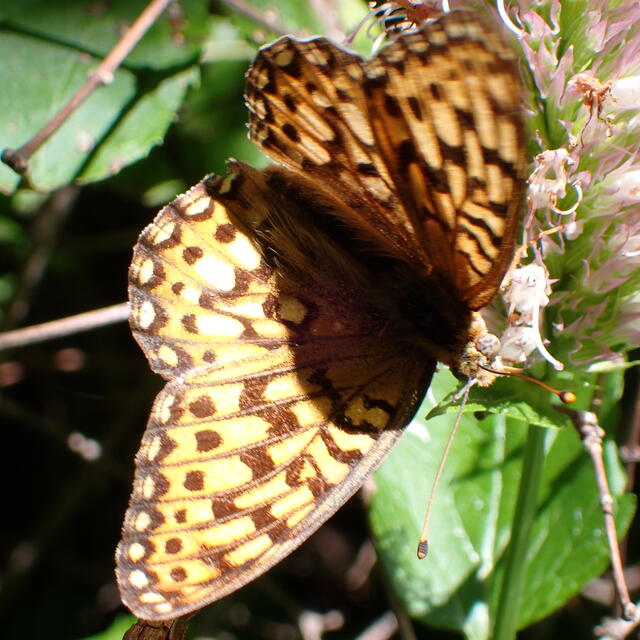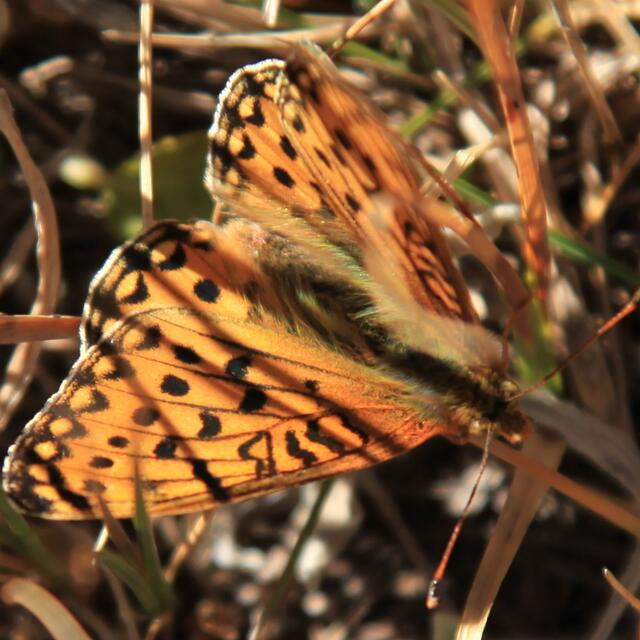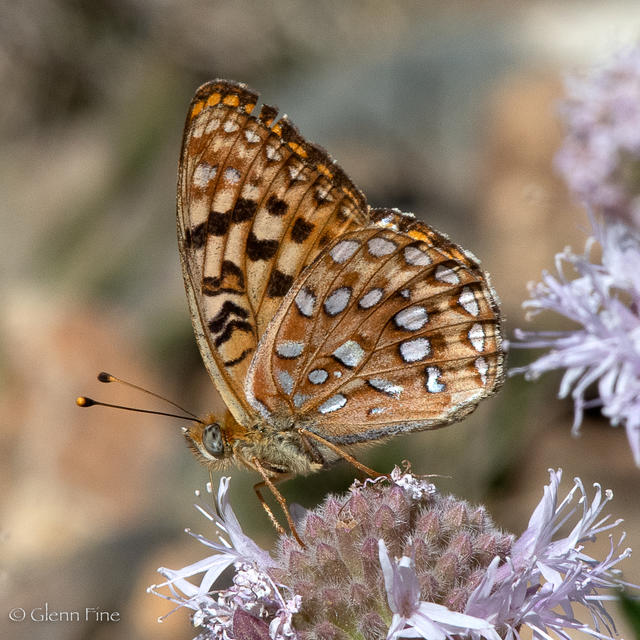Great Basin Fritillary
Speyeria egleis (Behr, 1862)
Family: Nymphalidae
Subfamily: Heliconiinae
Identification: Upperside bright to dull orange-brown with dark markings evenly spaced. Underside of hindwing has triangular, silver submarginal spots; other spots small with brown edging; spots may or may not be silvered.
Wing Span: 1 3/4 - 2 3/8 inches (4.5 - 6 cm).
Life History: Males patrol during the day for females, who lay eggs on leaf litter near violets. First-stage caterpillars hibernate unfed until spring, when they feed on violet leaves.
Flight: One brood from late June-August.
Caterpillar Hosts: Violets including Viola adunca, V. nuttallii, V. purpurea, and V. walteri.
Adult Food: Flower nectar.
Habitat: Mountain meadows, forest openings, exposed rocky ridges.
Range: North Dakota southwest through Oregon to California, south to Colorado.
Conservation: Not usually of concern but subspecies tehachapina has a very small range and could be devastated by a single event. Speyeria egleis tehachapina has The Nature Conservancy rank of T3 -Very rare or local throughout its range or found locally in a restricted range (21 to 100 occurrences). (Threatened throughout its range). Speyeria egleis as a whole has the The Nature Conservancy Global Rank of G5 - Demonstrably secure globally, though it may be quite rare in parts of its range, especially at the periphery.
NCGR:
Management Needs: Monitor subspecies tehachapina and evaluate for conservation action.
Comments: NULL
Please donate!
We depend on donations to keep Butterflies and Moths of North America freely available. We want to express our gratitude to all who showed their support by making a contribution this year. You can donate to support this project at any time.
Advertise with us!
Do you have a product or service that you think would interest BAMONA users? If you would like to advertise on this website, contact us by email, or use the contact form and select the "Advertising" category.
Verified Sightings
Displaying 1 - 24 of 431 verified sightings

Observation date: Aug 13, 2025
Submitted by: TomPeterson
Region: Mono County, California, United States
Verified by: Ken Davenport
Verified date: Aug 24, 2025

Observation date: Sep 14, 2005
Submitted by: papilio1
Region: Washoe County, Nevada, United States
Verified by: Ken Davenport
Verified date: May 11, 2025

Observation date: Sep 12, 2007
Submitted by: hank4044
Region: Lake County, Montana, United States
Verified by: J_Martineau
Verified date: Apr 22, 2025

Observation date: Jul 01, 2012
Submitted by: RobSimpson
Region: Park County, Wyoming, United States
Verified by: J_Martineau
Verified date: Apr 15, 2025

Observation date: Jul 18, 2024
Submitted by: Robert Gorman
Region: White Pine County, Nevada, United States
Verified by: Paul Prappas
Verified date: Aug 10, 2024

Observation date: Jun 22, 2024
Submitted by: cklindsey
Region: Columbia County, Washington, United States
Verified by: davidwdroppers
Verified date: Jul 16, 2024

Observation date: Jul 10, 2024
Submitted by: Paul Prappas
Region: Sierra County, California, United States
Verified by: Paul Prappas
Verified date: Jul 12, 2024

Observation date: Jul 08, 2024
Submitted by: hasfitz5
Region: Washoe County, Nevada, United States
Verified by: Ken Davenport
Verified date: Jul 12, 2024

Observation date: Jul 01, 2024
Submitted by: hasfitz5
Region: Washoe County, Nevada, United States
Verified by: Ken Davenport
Verified date: Jul 10, 2024

Observation date: Jun 28, 2024
Submitted by: glennfine
Region: Siskiyou County, California, United States
Verified by: Ken Davenport
Verified date: Jun 29, 2024

Observation date: Oct 08, 2023
Submitted by: rajanrao
Region: Alpine County, California, United States
Verified by: Ken Davenport
Verified date: Oct 11, 2023

Observation date: Oct 08, 2023
Submitted by: rajanrao
Region: Alpine County, California, United States
Verified by: Ken Davenport
Verified date: Oct 10, 2023

Observation date: Jul 23, 2017
Submitted by: dingoqueen
Region: Weber County, Utah, United States
Verified by: James Steen
Verified date: Sep 18, 2023

Observation date: Jul 23, 2017
Submitted by: mhearell
Region: Weber County, Utah, United States
Verified by: James Steen
Verified date: Sep 18, 2023

Observation date: Jul 04, 2018
Submitted by: Robb Hannawacker
Region: Utah County, Utah, United States
Verified by: James Steen
Verified date: Sep 12, 2023

Observation date: Aug 13, 2023
Submitted by: TomPeterson
Region: Alpine County, California, United States
Verified by: Ken Davenport
Verified date: Sep 02, 2023

Observation date: Jul 29, 2023
Submitted by: NikkiM
Region: Carbon County, Montana, United States
Verified by: J_Martineau
Verified date: Aug 11, 2023

Observation date: Jul 24, 2023
Submitted by: cklindsey
Region: Wallowa County, Oregon, United States
Verified by: Ken Davenport
Verified date: Aug 09, 2023

Observation date: Jul 07, 2023
Submitted by: Thom Garrett
Region: Missoula County, Montana, United States
Verified by: J_Martineau
Verified date: Aug 07, 2023

Observation date: Jul 25, 2023
Submitted by: madamirie
Region: Shasta County, California, United States
Verified by: Ken Davenport
Verified date: Aug 03, 2023

Observation date: Sep 03, 2022
Submitted by: NikkiM
Region: Carbon County, Montana, United States
Verified by: J_Martineau
Verified date: Feb 27, 2023

Observation date: Jul 09, 2022
Submitted by: NikkiM
Region: Carbon County, Montana, United States
Verified by: J_Martineau
Verified date: Feb 14, 2023

Observation date: Oct 10, 2022
Submitted by: NikkiM
Region: Wyoming, United States
Verified by: J_Martineau
Verified date: Jan 23, 2023

Observation date: Aug 16, 2022
Submitted by: glennfine
Region: Siskiyou County, California, United States
Verified by: Ken Davenport
Verified date: Aug 18, 2022
- 1 of 18
- next ›



